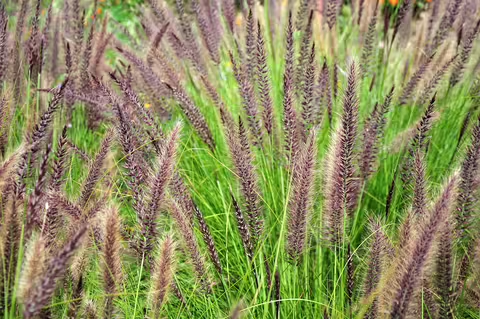Invasive Fountain Grasses
Fountain Grass Damage
These grasses can readily reseed and be aggressive, keeping out native plants. They have the potential to escape from ornamental plantings into natural areas and cause problems.
History of Fountain Grasses
Chinese Fountain Grass, Cenchrus alopecuroides, a non-native grass (formerly Pennisetum alopecuroides) and many other species of Fountain Grasses, like Crimson Fountain Grass, Cenchrus setaceus, are popular ornamental grasses. Many different cultivars exist and are widely planted. Unfortunately, this means that the chances for escape from cultivation are that much higher.
It may be underreported because of the difficulty that comes with identifying grasses, because some of them have a late bloom window, and because it is an escape from ornamental plantings.
Regulation
In the southwest part of the U.S., Crimson Fountain Grass is listed as an invasive species.
How to Identify Fountain Grasses
Currently the distribution on EDDMapS shows that Chinese Fountain Grass only occurs in two counties in Illinois, but my guess is it’s more widespread and just underreported.
Read more about how to identify Fountain Grasses in the blog Remove and Replace Fountain Grasses.
Chinese Fountain Grass
This warm-season bunchgrass can grow up to 3 feet tall, but the height varies depending on the cultivar. You can find hairs at the base of the leaf blades and along the stems. It flowers in late summer to early fall, producing a spike inflorescence. The spikelets are surrounded by long bristles that can range in color from whitish yellow to red to to purple to black depending on cultivar.
Crimson Fountain Grass
This warm-season bunchgrass can grow up to 4 feet tall. The leaves often have a reddish-purple hue to them. It flowers in late summer to early fall, producing a spike inflorescence. The spikelets are very hairy and surrounded by long bristles that range in color but are often red to purple.
Management of Fountain Grasses
Prevention
The number one step you can take is not planting these grasses in your home landscape. Looking up planting and care instructions for these grasses led me to find notes that this grass can readily reseed and be aggressive. Finding this information about a non-native plant should be a warning that they have the potential to escape into natural areas and cause problems.
There are so many native grass options that you could plant instead. Check out a few from a previous blog post here.
Report it if you find it
The distribution on EDDMapS shows that Chinese Fountain Grass only occurs in two counties in Illinois, but it is likely underreported. Report it it using the EDDMapS system or connect with your local Illinois Extension office.
Removal
Depending on the size of the infestation and surrounding vegetation, you could dig out the plants, or you could use a grass-specific herbicide.
